
Open Access
Available online http://ccforum.com/content/12/6/R147
Page 1 of 9
(page number not for citation purposes)
Vol 12 No 6
Research
Excess circulating angiopoietin-2 is a strong predictor of mortality
in critically ill medical patients
Philipp Kümpers1, Alexander Lukasz1, Sascha David1, Rüdiger Horn2, Carsten Hafer1,
Robert Faulhaber-Walter1, Danilo Fliser3, Hermann Haller1 and Jan T Kielstein1
1Department of Nephrology & Hypertension, Hannover Medical School, Carl-Neuberg-Strasse 1, Hannover, D-30171, Germany
2Department of Gastroenterology, Hepatology and Endocrinology, Hannover Medical School, Carl-Neuberg-Strasse 1, Hannover, D-30171, Germany
3Renal and Hypertensive Diseases, Saarland University Medical Centre, Kirrberger Straße, D-66421, Homburg/Saar, Germany
Corresponding author: Philipp Kümpers, kuempers.philipp@mh-hannover.de
Received: 22 Aug 2008 Revisions requested: 19 Sep 2008 Revisions received: 27 Oct 2008 Accepted: 21 Nov 2008 Published: 21 Nov 2008
Critical Care 2008, 12:R147 (doi:10.1186/cc7130)
This article is online at: http://ccforum.com/content/12/6/R147
© 2008 Kümpers et al.; licensee BioMed Central Ltd.
This is an open access article distributed under the terms of the Creative Commons Attribution License (http://creativecommons.org/licenses/by/2.0),
which permits unrestricted use, distribution, and reproduction in any medium, provided the original work is properly cited.
Abstract
Introduction The endothelial specific angiopoietin (Ang)-Tie2
ligand-receptor system has been identified as a non-redundant
mediator of endothelial activation in experimental sepsis.
Binding of circulating Ang-1 to the Tie2 receptor protects the
vasculature from inflammation and leakage, whereas binding of
Ang-2 antagonises Tie2 signalling and disrupts endothelial
barrier function. Here, we examine whether circulating Ang-1
and/or Ang-2 independently predict mortality in a cohort of
critically ill medical patients.
Methods Circulating vascular endothelial growth factor (VEGF),
Ang-1 and Ang-2 were prospectively measured in sera from 29
healthy controls and 43 medical ICU patients by
immunoradiometric assay (IRMA) and ELISA, respectively.
Survival after 30 days was the primary outcome studied.
Results Median serum Ang-2 concentrations were increasingly
higher across the following groups: healthy controls, patients
without sepsis, patients with sepsis and patients with septic
shock. In contrast, Ang-1 and VEGF concentrations were
significantly lower in all patient groups compared with healthy
controls. Ang-2 correlated with partial pressure of oxygen in
arterial blood (PaO2)/fraction of inspired oxygen (FiO2), tissue
hypoxia, Sequential Organ Failure Assessment (SOFA) and
Physiology and Chronic Health Evaluation II (APACHE II) score.
Multivariate Cox regression analyses confirmed a strong
independent prognostic impact of high Ang-2 as a novel marker
of 30-day survival.
Conclusions A marked imbalance of the Ang-Tie system in
favour of Ang-2 is present in critically ill medical patients. Our
findings highlight the independent prognostic impact of
circulating Ang-2 in critical illness. Ang-2 may be used as a
readily available powerful predictor of outcome and may open
new perspectives to individualise treatment in the ICU.
Introduction
In critically ill patients, impaired vascular barrier function is a
life-threatening feature that is causally determined by the acti-
vational state of the endothelial layer. In response to numerous
different stimuli, 'quiescent' endothelial cells (anti-coagulant,
anti-adhesive) undergo dramatic phenotypic changes towards
an 'activated', pro-coagulant, pro-adhesive state, which is par-
alleled by disassembly of adherence junctions (e.g. VE-cad-
herin) and myosin driven cell contraction, resulting in inter-
endothelial gap formation [1,2]. This highly regulated cascade
of events results in net extravasation of fluid, a profound
decrease in systemic vascular tone, collapse of the microcir-
culation and subsequent distributive shock, acute respiratory
distress syndrome (ARDS) and eventually multiple organ dys-
function syndrome (MODS) [1,3-5]. Thus, an important goal in
critical care medicine is to develop novel diagnostic and ther-
Ang: Angiopoietin; APACHE II: Acute Physiology and Chronic Health Evaluation II; ARDS: acute pulmonary distress syndrome; AUC: area under the
curve; CI: cardiac index; CRP: C-reactive protein; ELISA: Enzyme Linked Immuno Sorbent Assay; EVLWI: extravascular lung water index; FiO2: frac-
tion of inspired oxygen; HR: heart rate; ICU: intensive care unit; Ig: immunoglobulin; IRMA: immunoradiometric sandwich assay; ITBVI: intrathoracic
blood volume index; MAP: mean arterial pressure; MODS: multiple organ dysfunction syndrome; PaO2: partial pressure of oxygen in arterial blood;
PiCCO: Pulse contour Continous Cardiac Output; ROC: receiver operator characteristics; SEM: standard error of the mean; SOFA: Sequential
Organ Failure Assessment; SVRI: systemic vascular resistance index; VEGF: vascular endothelial growth factor.

Critical Care Vol 12 No 6 Kümpers et al.
Page 2 of 9
(page number not for citation purposes)
apeutic strategies to address excess endothelial activation in
the intensive care unit (ICU).
In 1996, Davis and colleagues discovered the angiopoietin
(Ang)-Tie2 ligand-receptor system as the second class of vas-
cular-specific receptor tyrosine kinases (the first being the vas-
cular endothelial growth factor (VEGF)/VEGF-receptor
system) [6]. Classically understood as an important regulator
in vessel maturation and remodelling, recent studies demon-
strated that the Ang-Tie2 system not only regulates angiogen-
esis, but also controls endothelial inflammation in a non-
redundant manner [7-9].
Ang-1 and Ang-2 are antagonistic ligands that bind with simi-
lar affinity to the extracellular domain of the Tie2 receptor,
which is almost exclusively expressed by endothelial cells.
Binding of the agonist Ang-1 to the Tie2 receptor promotes
vessel integrity, inhibits vascular leakage and suppresses
inflammatory gene expression [10,11]. Constitutively
expressed by pericytes and vascular smooth muscle cells,
Ang-1 provides a stabilisation signal [8,12,13]. In contrast,
Ang-2 inhibits binding of Ang-1 to Tie2, thereby disrupting
protective Tie2 signalling [10,13-15]. Ang-2, which is consid-
ered the dynamic part of the Ang-Tie2 ligand-receptor, is
stored and rapidly released by endothelial Weibel-Palade bod-
ies [8]. Depending on the context, Ang-2 may act as a Tie2
agonist, especially in the presence of VEGF [16-18]. Intrigu-
ingly, VEGF itself was first identified and characterised as a
potent stimulator of endothelial permeability and elevated cir-
culating levels of VEGF seem to correlate with severity of sep-
sis and septic shock [19-21].
So far, several studies have investigated circulating Ang-1 and
Ang-2 levels in critically ill patients [21-26]. Elevated Ang-2
concentrations correlate with the severity of illness as
assessed by injury severity score [22], organ failure index [24],
Acute Physiology and Chronic Health Evaluation (APACHE) II
scores and Sequential Organ Failure Assessment (SOFA)
scores [23,25,26]. In a recent study, we established and vali-
dated two novel immunoassays for the detection of circulating
Ang-1 and Ang-2 in critically ill patients [27]. Despite the
growing body of evidence indicating a role for Ang-2 as a
mediator in critically illness, the value of Ang-2 as a predictive
marker of outcome is poorly defined.
The aim of this study was to investigate the independent value
of circulating Ang-1 and Ang-2 as predictors of outcome in
critically ill medical patients.
Materials and methods
Patients
From the ICU at the Internal Medicine Department at Hannover
Medical School, Germany, a tertiary care university hospital,
43 patients were enrolled at the time of ICU admission and
studied prospectively. Patients were subdivided into the fol-
lowing groups: severe sepsis (n = 12), septic shock (n = 17)
and critically ill patients (n = 14) with no evidence or suspicion
of bacterial infection or sepsis (SCCM/ESICM/ACCP/ATS/
SIS definitions [28]). Enrollment was performed in a consecu-
tive fashion after obtaining written informed consents from the
patients or their legal representatives. If the patient was recov-
ering and able to communicate, he/she was informed of the
study purpose and consent was required to further maintain
status as study participant. The study was performed in
accordance with the declaration of Helsinki and approved by
the institutional review board. There were no co-morbidities
that led to exclusion, except for age younger than 18 years or
older than 75 years, being pregnant and having a malignant
neoplasm.
Subjects were ventilated in accordance with the ARDSNet-
derived protocol [29]. In 29 patients, invasive haemodynamic
monitoring was performed by the Pulse contour Continous
Cardiac Output (PiCCO) system (Pulsion Medical Systems,
Munich, Germany) in addition to standard techniques. This
device enables invasive on-line monitoring of several haemo-
dynamic parameters, such as mean arterial pressure (MAP),
heart rate (HR), cardiac index (CI), systemic vascular resist-
ance index (SVRI), intrathoracic blood volume index (ITBVI)
and extravascular lung water index (EVLWI), based on a
transpulmonary thermodilution technique [30,31]. All relevant
laboratory and medical data, including APACHE II [32] and
SOFA scores [33], were obtained at the time of enrollment.
Detailed patients' characteristics, including demographic, clin-
ical and laboratory parameters, are shown in Table 1.
Controls
Twenty-nine age- and gender-matched healthy volunteers
from the Hannover Medical School staff served as controls (16
males, 13 females; age 58 (25 to 73 years)).
Sampling
Serum samples for quantification of Ang-1, Ang-2 and VEGF
were obtained at the time of enrollment, immediately placed on
ice, centrifuged and stored at -80°C. All measurements were
performed in a blinded fashion by the same investigator.
Quantification of circulating Ang-1 and Ang-2
Ang-1 and Ang-2 were measured by in-house Immuno Radio-
metric Sandwich Assay (IRMA) and ELISA, respectively as
previously described [27,34]. Polyclonal, anti-human Ang-1
affinity purified goat immunoglobulin (Ig) G and a monoclonal
anti-human Ang-1 mouse antibody were obtained from R&D
Systems (R&D, Oxford, UK). Recombinant human Ang-1 was
purchased from Sigma-Aldrich (Sigma-Aldrich, Munich, Ger-
many). Recombinant human Ang-2 monoclonal Ang-2 anti-
body and anti-Ang-2 antibody were purchased from R&D
Systems (R&D, Oxford, UK).

Available online http://ccforum.com/content/12/6/R147
Page 3 of 9
(page number not for citation purposes)
Quantification of circulating VEGF
Serum VEGF was measured using a sandwich ELISA kit
according to the manufacturer's instructions (R&D Systems,
Minneapolis, USA). This assay measures biologically active
VEGF121 and VEGF165.
Statistical analysis
Differences between patients and healthy controls were eval-
uated using a non-parametric Kruskal-Wallis test. The Mann-
Whitney rank sum test was used for comparison between indi-
vidual groups. Correlations between variables were assessed
by the Spearman rank correlation coefficient. Pearson's corre-
lation coefficient and linear regression analysis was performed
after logarithmic transformation of Ang-2 values (logAng-2).
The primary outcome studied was 30-day survival and was cal-
culated from the day of ICU admission to death. Patients who
survived the follow-up period were censored at day 30. Param-
eters independently associated with survival were identified by
univariate and multivariate Cox proportional hazards models.
Variables found to be statistically significant at a 10% level in
the univariate analysis were included in the multivariate model
using backward elimination. Different models were estab-
lished, incorporating either Ang-2, logAng-2 or the Ang-2/
Ang-1 ratio, respectively. Two-sided p-values < 0.05 were
considered statistically significant for all statistical procedures
used. The distribution of the time-to-event variables were esti-
mated using the Kaplan-Meier method with log-rank testing.
Receiver operator characteristics (ROC) procedures were
used to identify optimal cut-off values. Data are displayed as
median and range (minimum to maximum) unless otherwise
stated. All statistical analyses were performed with the SPSS
Table 1
Demographic, clinical and laboratory characteristics of patients
Characteristics Total Non-septic patients Severe sepsis Septic shock
Number of patients 43 14 12 17
Male 25 (59%) 6 (43%) 5 (42%) 14 (82%)
Female 18 (41%) 8 (57%) 7 (58%) 3 (18%)
Age (years, median (min – max) 51 (21 to 73) 59 (37 to 73) 51 (43 to 69) 51 (39 to 64)
Reason for medical ICU admission
Pulmonary 15 (35%) 4 (29%) 3 (25%) 8 (47%)
Abdominal 10 (23%) 2 (14%) 4 (33%) 4 (24%)
Urogenital/retroperitoneal 3 (7%) 1(7%) 2 (17%) 0 (0%)
Cardiac 4 (9%) 3 (21%) 0 (0%) 1 (6%)
Cerebrovascular 4 (9%) 4 (29%) 0 (0%) 0 (0%)
Bloodstream infections 4 (9%) 0 (0%) 2 (17%) 2 (12%)
Miscellaneous 3 (7%) 0 (0%) 1 (8%) 2 (12%)
Mean arterial pressure (mmHg) 70 (40 to 96) 67 (53 to 84) 76 (67 to 91) 72 (60 to 81)
Heart rate (bpm) 100 (50 to 145) 102 (88 to 120) 90 (78 to 110) 106 (87 to 129)
Noradrenaline (μg/kg/min) 0.19 (0.0 to 1.96) 0.025 (0.0 to 0.07) 0.115 (0.02 to 0.18) 0.57 (0.32 to 0.77)
Mechanically ventilated, no. 36 (84%) 6 (43%) 12 (100%) 17 (100%)
FiO2 (%) 45 (26 to 100) 40 (34.53) 42 (35 to 62) 50 (59 to 60)
PaO2/FiO2 240 (68 to 640) 269 (218 to 367) 200 (130 to 257) 190 (138 to 272)
CRP (mg/L) 129 (51 to 268) 117 (5 to 194) 172 (79 to 304) 136 (54 to 282)
Creatinine (mmol/L) 251 (160 to 401) 116 (54 to 302) 354 (210 to 431) 273 (188 to 427)
Lactate (mmol/L) 1.9 (1.2 to 2.9) 1.3 (0.9 to 2.0) 1.6 (1.0 to 2.1) 2.9 (2.1 to 10.6)
APACHE II score 30 (6 to 48) 26 (17 to 30) 32 (25 to 35) 32 (29 to 38)
SOFA score 16 (1 to 22) 8 (4 to 11) 17 (14 to 20) 18 (16 to 20)
Mortality 25 (59%) 4 (29%) 8 (67%) 13 (77%)
APACHE II = Acute Physiology And Chronic Health Evaluation score; CRP = C-reactive protein; FiO2 = fraction of inspired oxygen; ICU =
intensive care unit; PaO2 = partial pressure of oxygen in arterial blood; SOFA = Sequential Organ Failure Assessment score.

Critical Care Vol 12 No 6 Kümpers et al.
Page 4 of 9
(page number not for citation purposes)
package (SPSS Inc., Chicago, IL, USA) and the GraphPad
Prism software (GraphPad Prism Software Inc. San Diego,
California, USA).
Results
Decreased Ang-1 and VEGF concentrations and
increased Ang-2 concentrations in critically ill medical
patients
Ang-1 concentrations in critically ill non-septic patients (0.8
ng/ml, 0.5 to 11.7 ng/ml), patients with severe sepsis (0.5 ng/
ml, 0.3 to 18.8 ng/ml) and patients with septic shock (0.9 ng/
ml, 0.3 to 5.5 ng/ml were markedly decreased compared with
healthy controls (56.4 ng/ml, 34.5 to 71.3 ng/ml, p < 0.0001)
(Figure 1a). Ang-1 concentrations were no different between
severe sepsis, septic shock and non-septic patients.
In contrast, median serum Ang-2 concentrations were consist-
ently increased in critically ill non-septic patients (2.8 ng/ml,
1.0 to 9.0 ng/ml), in patients with severe sepsis (16.45 ng/ml,
2.7 to 39.7 ng/ml) and patients with septic shock (28.1 ng/ml,
3.7 to 72.6 ng/ml), compared with healthy controls (0.9 ng/ml,
0.3 to 2.6 ng/ml; all p < 0.0001 versus controls) (Figure 1b).
Ang-2 was higher in patients with sepsis compared with non-
septic patients (both p < 0.0001). Ang-2 concentrations were
not different between patients with severe sepsis and septic
shock (p = 0.12). Ang-1 and Ang-2 concentrations were nei-
ther linked to gender (Mann-Whitney test: p = 0.42 and p =
0.51) nor age (Spearman correlation: p = 0.83 and p = 0.24).
VEGF concentrations were markedly lower in critically ill non-
septic patients (43.5 pg/ml, 4.1 to 200.0 pg/ml), patients with
severe sepsis (112.7 pg/ml, 34.9 to 569.1 pg/ml) and patients
with septic shock (70.5 pg/ml, 3.7 to 179.9 pg/ml compared
with healthy controls (515.5 pg/ml, 280.6 to 1294.0 pg/ml, all
p < 0.0001) (Figure 1c). VEGF concentrations were no differ-
ent between patients with severe sepsis, patients with septic
shock and non-septic controls. VEGF concentrations were not
linked to gender (p = 0.67) and did not correlate with age (p
= 0.33).
Circulating Ang-2 concentrations correlate with SOFA
and APACHE II scores
Linear regression analysis detected a strong association of
logAng-2 concentration with APACHE II scores (r2 = 0.28, p
= 0.0003) and SOFA scores (r2 = 0.62, p < 0.0001) (Figures
2a,b; n = 43). Hypoxia has been shown to induce the release
of Ang-2 from endothelial cells in preclinical models [35,36].
Of note, a strong correlation between Ang-2 concentrations
and lactate levels as a surrogate marker for tissue hypoper-
fusion and microcirculatory tissue hypoxia was detected (r2 =
0.25, p = 0.0007). Neither Ang-1 nor VEGF correlated with
APACHE II scores, SOFA scores or C-reactive protein (CRP)
levels.
Figure 1
Box plots of results in healthy controls and study patientsBox plots of results in healthy controls and study patients. Circulat-
ing (a) Angiopoietin (Ang) 1, (b) Ang-2 and (c) vascular endothelial
growth factor (VEGF) serum concentrations in healthy controls (n =
29), critically ill patients without infection (no sepsis; n = 14), patients
with severe sepsis (n = 12) and septic shock (n = 17). Horizontal bars
indicate median values.

Available online http://ccforum.com/content/12/6/R147
Page 5 of 9
(page number not for citation purposes)
Association of Ang-1, Ang-2 and VEGF with pulmonary
function and haemodynamics
Pre-clinical models have impressively demonstrated that the
intact Ang-1/Tie2 signalling protects from ARDS in experimen-
tal sepsis [36-38]. We therefore examined the association
between several parameters of haemodynamic and pulmonary
function with circulating Ang-1, Ang-2 and VEGF levels. Of
those, only Ang-2 showed an inverse correlation with partial
pressure of oxygen in arterial blood (PaO2)/fraction of inspired
oxygen (FiO2) (r2 = -0.31; p = 0.046), and PaO2 (r2 = -0.35; p
= 0.023) as surrogate markers for ventilator support and pul-
monary function. No association was seen for peak airway
pressure (p = 0.6) or positive end expiratory pressure levels (p
= 0.45). In addition to routine invasive haemodynamic monitor-
ing (n = 43), 29 ventilated patients without atrial fibrillation
qualified for detailed haemodynamic assessment by transpul-
monary thermodilution technique (PiCCO system). Surpris-
ingly, none of the measured angiogenic factors correlated with
any of the haemodynamic parameters (MAP, CI, EVLWI, ITBVI,
SVRI, vasopressor dose or central venous pressure; data not
shown). The same results were obtained for invasive routine
monitoring in all 43 patients (data not shown).
Circulating Ang-2 predicts mortality in critically ill
patients
To determine the relation between Ang-2 levels at admission
and mortality, we initially performed univariate Cox proportional
hazards analyses. In our whole cohort of critically ill medical
patients, age, gender or the presence of sepsis did not show
prognostic significance for survival (Table 2). The same was
true for MAP, HR, CVP, urine output, noradrenaline dose,
FiO2, PaO2/FiO2, thrombocytes, bilirubin, CRP and VEGF
(Table 2). Among the tested variables, lactate (p = 0.006),
APACHE II score (p = 0.013), SOFA score (p = 0.038) and
the amount of circulating Ang-2 (p = 0.001) displayed prog-
nostic significance (Table 2).
Subsequently, the following variables were found to be statis-
tically significant at a 10% level in the univariate analysis and
subjected to multivariate Cox regression analysis: lactate,
APACHE II score, SOFA score and circulating Ang-2 (Table
2). Except for Ang-2 (p = 0.002), all other variables did not
remain significant in the multivariate setting (lactate (p =
0.111), APACHE II score (p = 0.154), SOFA score (p =
0.167)). The same results were obtained when either logAng-
2 (p = 0.003) or the Ang-2/Ang-1 ratio (p = 0.036) were
tested instead of Ang-2 (Table 2). Thus, circulating Ang-2 was
identified as a strong, independent prognostic factor for 30-
day survival in our cohort of critically ill medical patients. Given
the context-dependent synergistic effects of Ang-2 and VEGF,
we analysed various ratios incorporating Ang-1, Ang-2 and
VEGF (data not shown). Except for the Ang-2/Ang-1 ratio,
none of these models reached statistical significance (Table
2).
Ang-2 yielded an area under the ROC curve (AUC) value of
0.79 (standard error of the mean (SEM) = 0.07; 95% confi-
dence interval = 0.65 to 0.93; p = 0.001). For comparison, the
APACHE II score yielded an AUC value of 0.75 (SEM = 0.08;
95% confidence interval = 0.59 to 0.91; p = 0.005). A median
circulating Ang-2 of more than 11.08 ng/ml predicted death
with a specificity of 74% (95% confidence interval = 57 to 86)
and a sensitivity of 67% (95% confidence interval = 54 to 77).
The odds ratio for 30-day mortality was 5.6 (95% confidence
interval = 1.5 to 20.5), positive and negative predictive values
were 76% (95% confidence interval = 61 to 88) and 64%
(95% confidence interval = 49 to 75), respectively.
Figure 3 illustrates the Kaplan-Meier curves of 30-day survival
stratified to Ang-2 (less versus higher than median (11.08 ng/
ml)). Log rank test confirmed statistical significance for Ang-2
(p = 0.009). Accordingly, the hazard for Ang-2 (> median) in
Figure 2
Scatter plots showing correlations of resultsScatter plots showing correlations of results. Correlations of Ang-2
serum concentrations with (a) the Acute Physiology and Chronic
Health Evaluation (APACHE) II score and (b) the Sequential Organ
Failure Assessment (SOFA) score in 43 critically ill patients (non-septic
patients (n = 14); severe sepsis (n = 12) and septic shock (n = 17)).

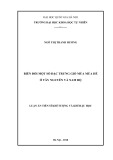
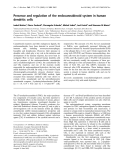
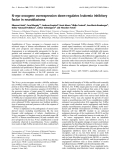
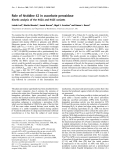
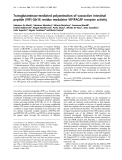
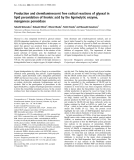
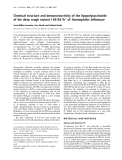
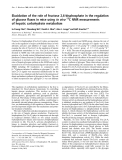
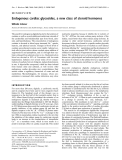
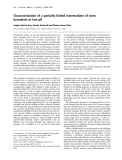





![Báo cáo seminar chuyên ngành Công nghệ hóa học và thực phẩm [Mới nhất]](https://cdn.tailieu.vn/images/document/thumbnail/2025/20250711/hienkelvinzoi@gmail.com/135x160/47051752458701.jpg)









